Abstract
An apparently specific glutathione oxidase activity is present in renal cortex, epididymal caput, jejunal villus tip cells, choroid plexus, and retina (but not in liver). The activity is membrane-bound and is localized on the luminal surface of the brush border membranes of the kidney and jejunum. The distribution and localization of the oxidase are similar to those of gamma-glutamyl transpeptidase, suggesting that there is a significant relationship among the translocation of intracellular glutathione, the extracellular oxidation of glutathione to glutathione disulfide, and the reactions of the gamma-glutamyl cycle. Thus, both glutathione present in the blood plasma and intracellular glutathione translocated to the cell surface are accessible to oxidation and transpeptidation. Acceptor substrates of the transpeptidase (e.g., L amino acids) promote transpeptidation and decrease oxidation of glutathione. Conversion of glutathione to glutathione disulfide is followed by utilization of the latter compound by gamma-glutamyl transpeptidase and dipeptidase. Although intracellular oxidation of glutathione to glutathione disulfide is readily reversed by the action of glutathione reductase, glutathione disulfide formed extracellularly cannot be reduced; instead, it undergoes hydrolytic and transpeptidation reactions leading to gamma-glutamyl amino acid and amino acid products which may be recovered by being transported into the cell.
Full text
PDF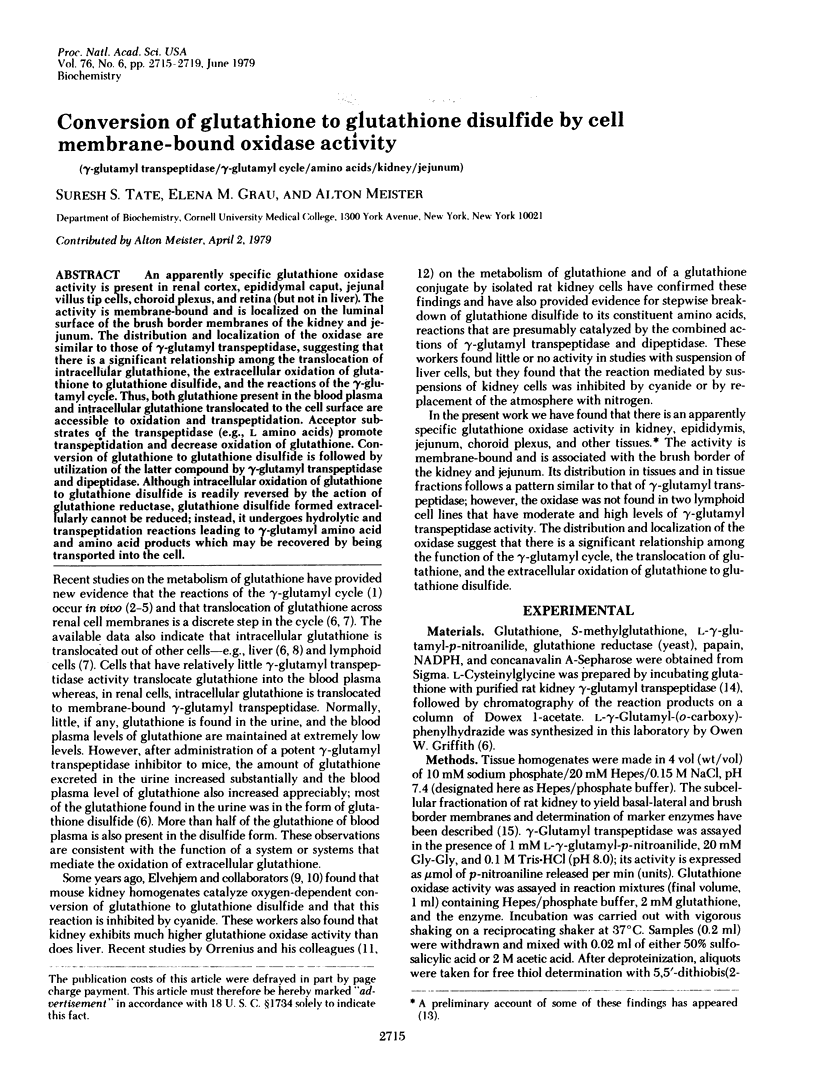
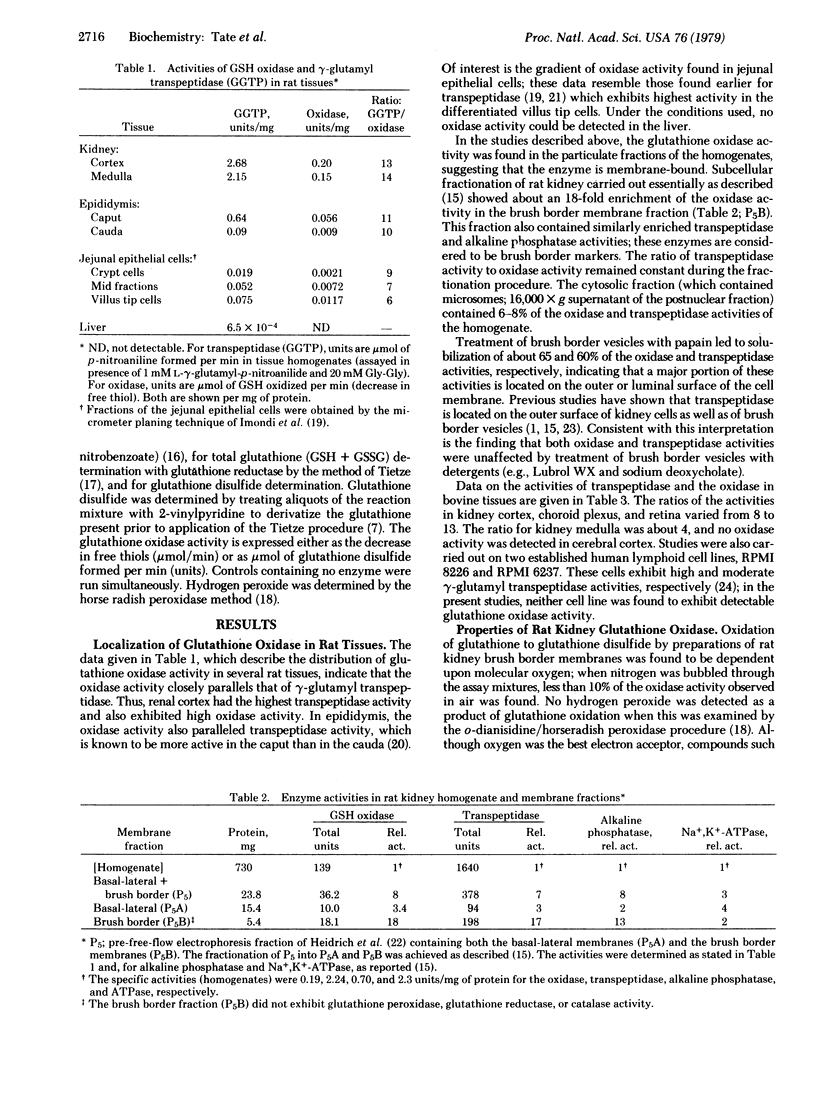
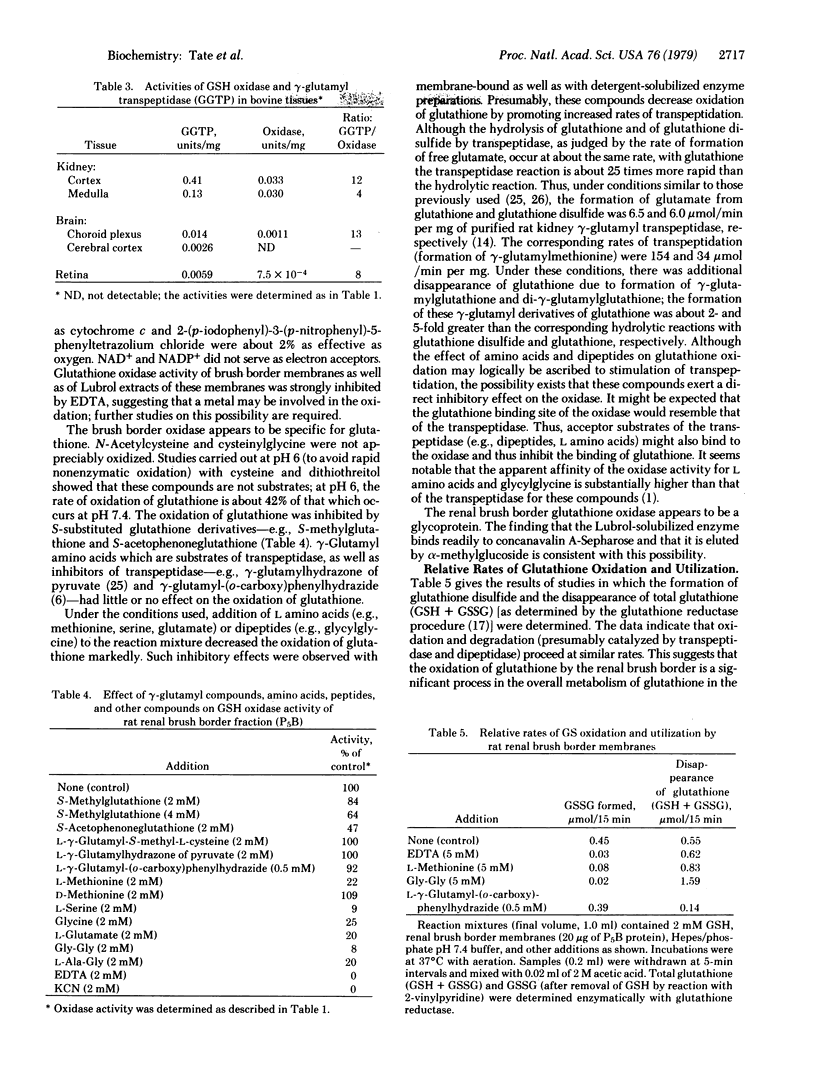
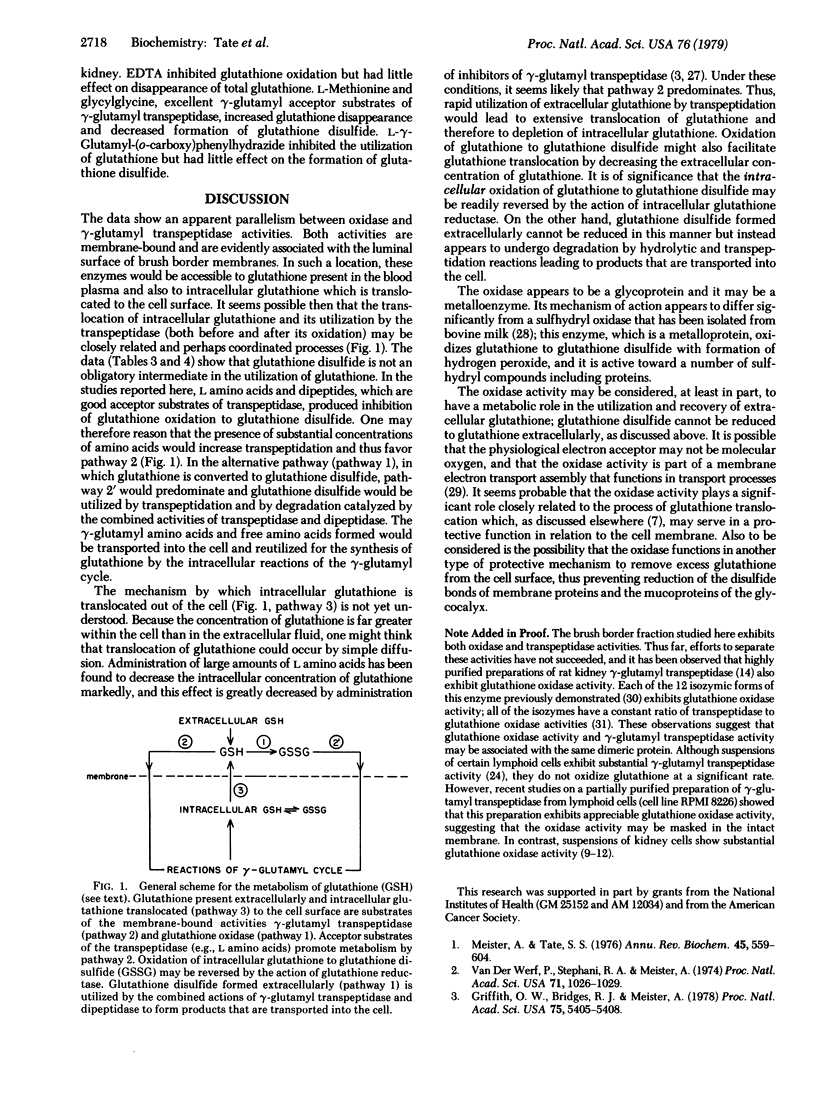
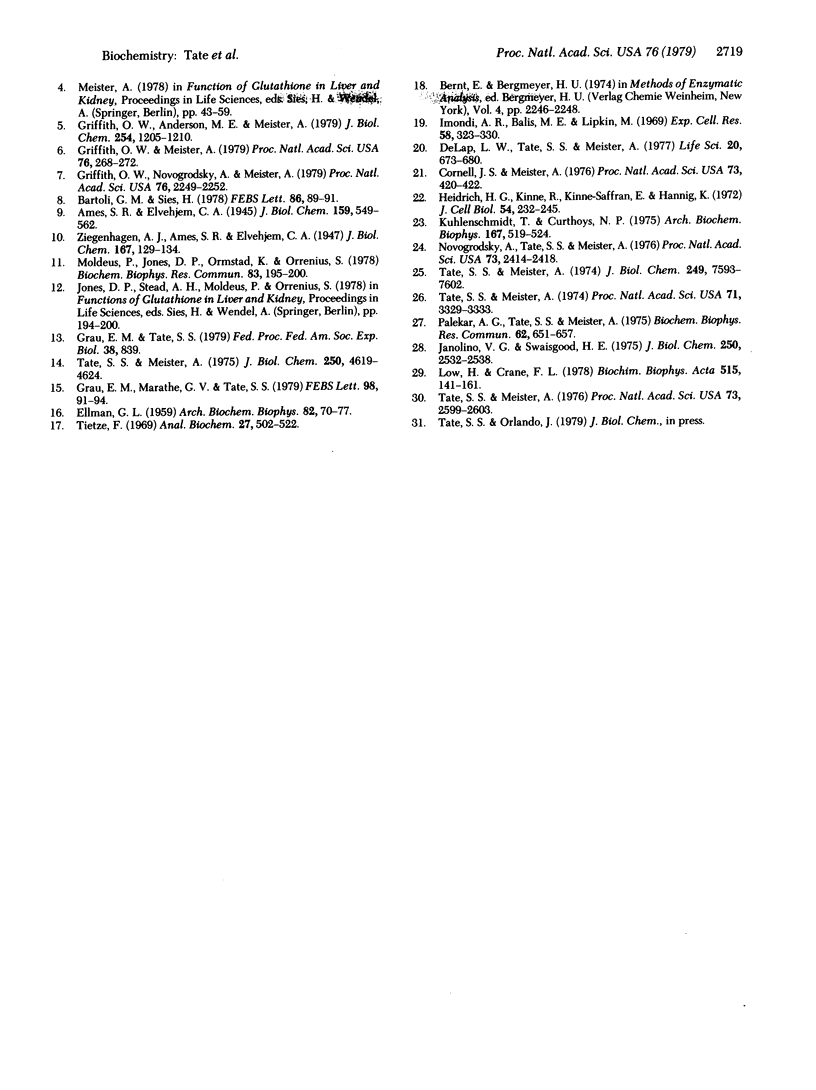
Selected References
These references are in PubMed. This may not be the complete list of references from this article.
- Bartoli G. M., Sies H. Reduced and oxidized glutathione efflux from liver. FEBS Lett. 1978 Feb 1;86(1):89–91. doi: 10.1016/0014-5793(78)80105-7. [DOI] [PubMed] [Google Scholar]
- Cornell J. S., Meister A. Glutathione and gamma-glutamyl cycle enzymes in crypt and villus tip cells of rat jejunal mucosa. Proc Natl Acad Sci U S A. 1976 Feb;73(2):420–422. doi: 10.1073/pnas.73.2.420. [DOI] [PMC free article] [PubMed] [Google Scholar]
- DeLap L. W., Tate S. S., Meister A. gamma-glutamyl transpeptidase and related enzyme activities inthe reproductive system of the male rat. Life Sci. 1977 Feb 15;20(4):673–679. doi: 10.1016/0024-3205(77)90472-6. [DOI] [PubMed] [Google Scholar]
- ELLMAN G. L. Tissue sulfhydryl groups. Arch Biochem Biophys. 1959 May;82(1):70–77. doi: 10.1016/0003-9861(59)90090-6. [DOI] [PubMed] [Google Scholar]
- Grau E. M., Marathe G. V., Tate S. S. Rapid purification of rat kidney brush borders enriched in gamma-glutamyl transpeptidase. FEBS Lett. 1979 Feb 1;98(1):91–95. doi: 10.1016/0014-5793(79)80159-3. [DOI] [PubMed] [Google Scholar]
- Griffith O. W., Anderson M. E., Meister A. Inhibition of glutathione biosynthesis by prothionine sulfoximine (S-n-propyl homocysteine sulfoximine), a selective inhibitor of gamma-glutamylcysteine synthetase. J Biol Chem. 1979 Feb 25;254(4):1205–1210. [PubMed] [Google Scholar]
- Griffith O. W., Bridges R. J., Meister A. Evidence that the gamma-glutamyl cycle functions in vivo using intracellular glutathione: effects of amino acids and selective inhibition of enzymes. Proc Natl Acad Sci U S A. 1978 Nov;75(11):5405–5408. doi: 10.1073/pnas.75.11.5405. [DOI] [PMC free article] [PubMed] [Google Scholar]
- Griffith O. W., Meister A. Translocation of intracellular glutathione to membrane-bound gamma-glutamyl transpeptidase as a discrete step in the gamma-glutamyl cycle: glutathionuria after inhibition of transpeptidase. Proc Natl Acad Sci U S A. 1979 Jan;76(1):268–272. doi: 10.1073/pnas.76.1.268. [DOI] [PMC free article] [PubMed] [Google Scholar]
- Griffith O. W., Novogrodsky A., Meister A. Translocation of glutathione from lymphoid cells that have markedly different gamma-glutamyl transpeptidase activities. Proc Natl Acad Sci U S A. 1979 May;76(5):2249–2252. doi: 10.1073/pnas.76.5.2249. [DOI] [PMC free article] [PubMed] [Google Scholar]
- Heidrich H. G., Kinne R., Kinne-Saffran E., Hannig K. The polarity of the proximal tubule cell in rat kidney. Different surface charges for the brush-border microvilli and plasma membranes from the basal infoldings. J Cell Biol. 1972 Aug;54(2):232–245. doi: 10.1083/jcb.54.2.232. [DOI] [PMC free article] [PubMed] [Google Scholar]
- Imondi A. R., Balis M. E., Lipkin M. Changes in enzyme levels accompanying differentiation of intestinal epithelial cells. Exp Cell Res. 1969 Dec;58(2):323–330. doi: 10.1016/0014-4827(69)90512-6. [DOI] [PubMed] [Google Scholar]
- Janolino V. G., Swaisgood H. E. Isolation and characterization of sulfhydryl oxidase from bovine milk. J Biol Chem. 1975 Apr 10;250(7):2532–2538. [PubMed] [Google Scholar]
- Kuhlenschmidt T., Curthoys N. P. Subcellular localization of rat kidney phosphate independent glutaminase. Arch Biochem Biophys. 1975 Apr;167(2):519–524. doi: 10.1016/0003-9861(75)90494-4. [DOI] [PubMed] [Google Scholar]
- Löw H., Crane F. L. Redox function in plasma membranes. Biochim Biophys Acta. 1978 Jul 31;515(2):141–161. doi: 10.1016/0304-4157(78)90002-3. [DOI] [PubMed] [Google Scholar]
- Meister A., Tate S. S. Glutathione and related gamma-glutamyl compounds: biosynthesis and utilization. Annu Rev Biochem. 1976;45:559–604. doi: 10.1146/annurev.bi.45.070176.003015. [DOI] [PubMed] [Google Scholar]
- Moldéus P., Jones D. P., Ormstad K., Orrenius S. Formation and metabolism of a glutathione-S-conjugate in isolated rat liver and kidney cells. Biochem Biophys Res Commun. 1978 Jul 14;83(1):195–200. doi: 10.1016/0006-291x(78)90416-3. [DOI] [PubMed] [Google Scholar]
- Novogrodsky A., Tate S. S., Meister A. gamma-Glutamyl transpeptidase, a lymphoid cell-surface marker: relationship to blastogenesis, differentiation, and neoplasia. Proc Natl Acad Sci U S A. 1976 Jul;73(7):2414–2418. doi: 10.1073/pnas.73.7.2414. [DOI] [PMC free article] [PubMed] [Google Scholar]
- Palekar A. G., Tate S. S., Meister A. Decrease in glutathione levels of kidney and liver after injection of methionine sulfoximine into rats. Biochem Biophys Res Commun. 1975 Feb 3;62(3):651–657. doi: 10.1016/0006-291x(75)90448-9. [DOI] [PubMed] [Google Scholar]
- Tate S. S., Meister A. Identity of maleate-stimulated glutaminase with gamma-glutamyl transpeptidase in rat kidney. J Biol Chem. 1975 Jun 25;250(12):4619–4627. [PubMed] [Google Scholar]
- Tate S. S., Meister A. Interaction of gamma-glutamyl transpeptidase with amino acids, dipeptides, and derivatives and analogs of glutathione. J Biol Chem. 1974 Dec 10;249(23):7593–7602. [PubMed] [Google Scholar]
- Tate S. S., Meister A. Stimulation of the hydrolytic activity and decrease of the transpeptidase activity of gamma-glutamyl transpeptidase by maleate; identity of a rat kidney maleate-stimulated glutaminase and gamma-glutamyl transpeptidase. Proc Natl Acad Sci U S A. 1974 Sep;71(9):3329–3333. doi: 10.1073/pnas.71.9.3329. [DOI] [PMC free article] [PubMed] [Google Scholar]
- Tate S. S., Meister A. Subunit structure and isozymic forms of gamma-glutamyl transpeptidase. Proc Natl Acad Sci U S A. 1976 Aug;73(8):2599–2603. doi: 10.1073/pnas.73.8.2599. [DOI] [PMC free article] [PubMed] [Google Scholar]
- Tietze F. Enzymic method for quantitative determination of nanogram amounts of total and oxidized glutathione: applications to mammalian blood and other tissues. Anal Biochem. 1969 Mar;27(3):502–522. doi: 10.1016/0003-2697(69)90064-5. [DOI] [PubMed] [Google Scholar]
- Van Der Werf P., Stephani R. A., Meister A. Accumulation of 5-oxoproline in mouse tissues after inhibition of 5-oxoprolinase and administration of amino acids: evidence for function of the gamma-glutamyl cycle. Proc Natl Acad Sci U S A. 1974 Apr;71(4):1026–1029. doi: 10.1073/pnas.71.4.1026. [DOI] [PMC free article] [PubMed] [Google Scholar]


